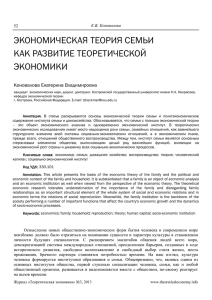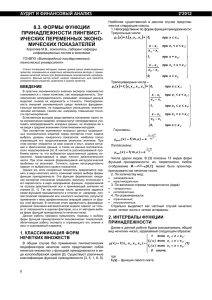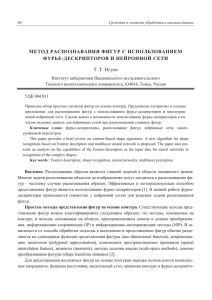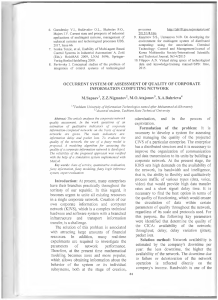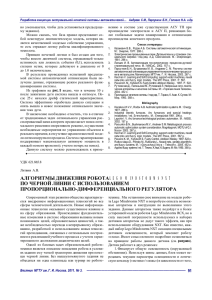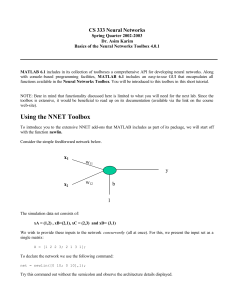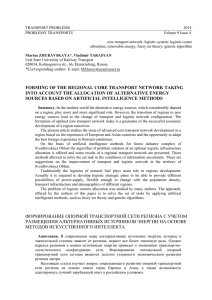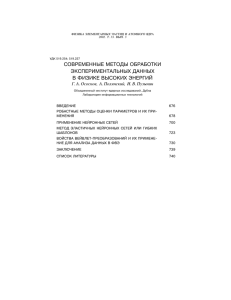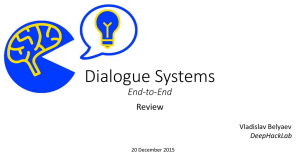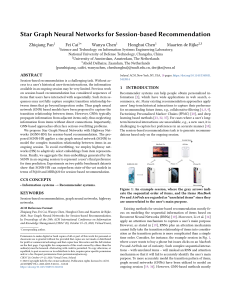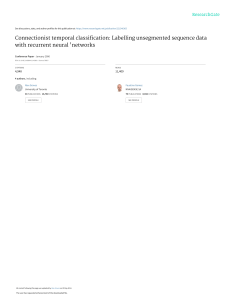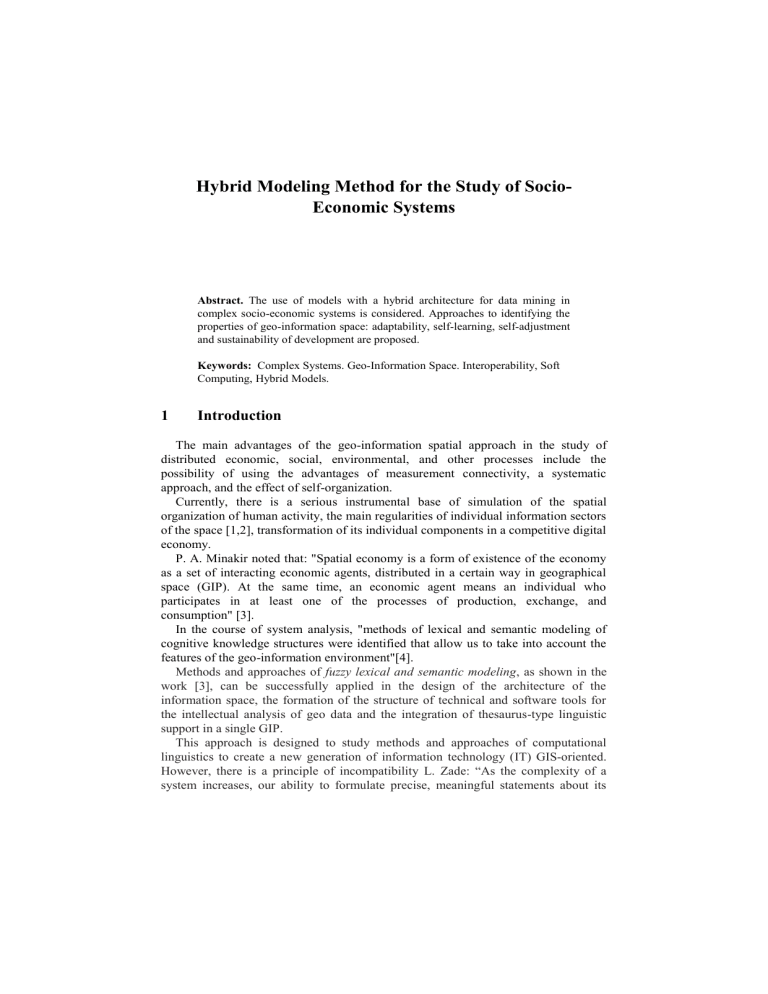
Hybrid Modeling Method for the Study of SocioEconomic Systems
Abstract. The use of models with a hybrid architecture for data mining in
complex socio-economic systems is considered. Approaches to identifying the
properties of geo-information space: adaptability, self-learning, self-adjustment
and sustainability of development are proposed.
Keywords: Complex Systems. Geo-Information Space. Interoperability, Soft
Computing, Hybrid Models.
1
Introduction
The main advantages of the geo-information spatial approach in the study of
distributed economic, social, environmental, and other processes include the
possibility of using the advantages of measurement connectivity, a systematic
approach, and the effect of self-organization.
Currently, there is a serious instrumental base of simulation of the spatial
organization of human activity, the main regularities of individual information sectors
of the space [1,2], transformation of its individual components in a competitive digital
economy.
P. A. Minakir noted that: "Spatial economy is a form of existence of the economy
as a set of interacting economic agents, distributed in a certain way in geographical
space (GIP). At the same time, an economic agent means an individual who
participates in at least one of the processes of production, exchange, and
consumption" [3].
In the course of system analysis, "methods of lexical and semantic modeling of
cognitive knowledge structures were identified that allow us to take into account the
features of the geo-information environment"[4].
Methods and approaches of fuzzy lexical and semantic modeling, as shown in the
work [3], can be successfully applied in the design of the architecture of the
information space, the formation of the structure of technical and software tools for
the intellectual analysis of geo data and the integration of thesaurus-type linguistic
support in a single GIP.
This approach is designed to study methods and approaches of computational
linguistics to create a new generation of information technology (IT) GIS-oriented.
However, there is a principle of incompatibility L. Zade: “As the complexity of a
system increases, our ability to formulate precise, meaningful statements about its
behavior decreases to a certain threshold, beyond which accuracy and meaning
become mutually exclusive” [5].
At the same time the assessment of the adequacy of the model to the actual object
of management in socio-economic systems is related to the set of accepted restrictions
on the studied (in fact, fuzzy) dynamic system.
System studies of the socio-economic component (SEC) of the UGIS suggest that
“as a result, both the conditions for its formation will be optimized, and also the
effectiveness of further functioning and development”[6]. Special attention in SEC
research "should be paid to the study of the causal relationships of the behavior of the
socio-economic system and the identification of its structure and properties that will
ensure the effective implementation of the goals of the activities" [7].
2
Chaos in the socio-economic system
Real socio-economic systems have an almost complete set of “NON-factors:
inaccuracy, vagueness, incompleteness, undefinability, etc." [8]. However, not all of
them can be taken into account using traditional probability theory and mathematical
statistics [9.10]. For complex modern systems such as System of Systems (SOS),
which, of course, include SEC, which have "strange" attractors in their phase portraits
(so-called «butterfly effect»)[11], there is a chaos caused by "deterministic
randomness", and, consequently, by the nonlinearities of the general model and a
certain set of initial conditions [11,12]. Even the slightest disturbance of such a
complex system as the SEC, for example, the weather, not to mention the economic
crisis or coronovirus, can lead to a chain of events leading to complete
unpredictability. There is no alternative to using soft models in this situation.
In the course of modeling, individual properties can be aggregated, for example, by
manageability, to ensure clarity and speed in obtaining the result. Among the
properties of complex nonlinear SEC, the properties of dynamism, flexibility and
adaptability are of particular importance, which, in turn, determine stability and,
ultimately, efficiency [11].
The research of UGIS should be based on the principle of consistency in order to
consider each layer as an aggregate of components of semantically related types that
have heterogeneous properties but co-exist in a certain cognitive space.
All types of spaces of UGIS have “a number of common properties: the length in
different directions, the mutual location of space objects, nodes (centers), networks,
etc. The most important advantage of the spatial approach is the possibility of a multidimensional representation of a spatially localized system” [6].
3
Lyapunov's Time
Lyapunov time is the time during which the system comes to a state of chaos. In
other words, this is the time during which you can predict the behavior of the system
(the “non-chaos” time). It is possible to calculate if to use the Lyapunov’s exponent
for the dynamic SEC, that is, the speed with which the two points in phase space
converge or move away from each other:
𝑛
1
𝑑𝑓(𝑥𝑘 )
= lim ∑ log 2 |
|.
𝑛→∞
𝑛
𝑑𝑥𝑘
𝑘=0
The meaning of this indicator: when the distance 𝑑𝑓(𝑥𝑘 ) changes at the k-step in
comparison with the corresponding parameter 𝑑𝑥𝑘 in a larger direction, the value of
the Lyapunov’s exponent > 0, it means that there is chaos or instability of the SEC
system. When 𝑑𝑓(𝑥𝑘 ) is at the k-step, in comparison with the corresponding
parameter 𝑑𝑥𝑘 in the smaller direction, the logarithm of a number less than one is
negative, 0 - SEC - is stable.
Modeling of socio-economic systems
The solution of this type of multi-criteria modeling problems in the UGIS involves
the use of mathematical systems that describe the main processes of functioning of
this SoS.
As a hybrid, they usually use [4,13]:
- neuro computing+fuzzy logic (NF);
- fuzzy logic+chaos theory (FCh);
- neural networks+chaos theory (NCh), etc.
4
Modeling
Let's consider an example of chaos formation in an absolutely deterministic
Lorentz model in the Cauchy form [2], given by a system of three nonlinear firstorder differential equations.
«The next slide shows a phase portrait of the system's behavior, where the presence
of a strange attractor is obvious even visually. Such qualitative research is convenient
for rapid analysis of the state of society for the operational forecast of chaos.
For a more accurate forecast, it is desirable to obtain information about the stability
margin of the current trend.
The algorithm for quantifying the state of the system model assumes the following
sequence of actions»[15]:
1) forming the Cauchy model, for example:
𝑥̇ = −𝑘(𝑥 − 𝑦)
{𝑦̇ = −𝑥𝑧 − 𝑦 + 𝑝𝑥 ;
𝑧̇ = −𝑞𝑧 + 𝑥𝑦
2) obtaining a Jacobi matrix composed of partial derivatives of the right-hand
sides of the corresponding differential equations
−10
10
0
−𝑘
𝑘
0
−𝑧
+
28
−1
−𝑥
−𝑧
+
𝑝
−1
−𝑥
[
]=[
];
𝑦
𝑥 −11
𝑦
𝑥 −𝑞
3) substitution of initial conditions
−10
[−𝑧0 + 28
𝑦0
10
−1
𝑥0
0
−𝑥0 ];
−11
4) finding the eigenvalues of the resulting numerical matrix - for n=3 there will
be 3 of them: 𝞵1, 𝞵2, 𝞵3 ;
5) finding first-order Lyapunov exponents as the real part of the eigenvalue
𝜆𝑗1 =Re 𝜇1𝑗 ;
6) finding a one-dimensional Lyapunov exponent 𝜆1 = max 𝜆𝑗1 ;
𝑗
7) finding 𝜆21 = 𝜆11 + 𝜆12 ; 𝜆22 = 𝜆11 + 𝜆13 ; 𝜆23 = 𝜆13 + 𝜆12 ;
8) finding 𝜆2 = max 𝜆𝑗2 ;
𝑗
9) finding 𝜆31 = 𝜆11 + 𝜆12 + 𝜆13
In this case, the information space of the socio-economic system is formed, within
which the zones of its predictive behavior are found, using Lyapunov indicators [4].
5
A model for evaluating UGIS as a complex information SoS
The complexity of modeling SEC as a subsystem of the UGIS is due to [3.14]:
- the complexity of the research object, the non-linearity and undefinability of
processes and initial conditions, the presence of threshold effects,
bifurcations and time lags (differential models of SEC with a delay);
- the effect of interaction of SEC model variables, which mostly implement
NON-factors;
- the complexity of measuring fuzzy variables of the model;
- fuzzy and unstable relationships in the model;
- significant influence of the human factor on all socio-economic processes.
As a result of “hybridization of methods of intellectual data processing, combining
several artificial intelligence technologies, the term soft computing appeared” [8],
which was introduced by L. Zadeh in 1994. "Soft computing is a set of computational
methodologies that provide a framework for understanding, designing, and
developing intelligent systems. Soft Computing combines areas such as probabilistic
reasoning and evolutionary algorithms, artificial neural networks (NN), and fuzzy
logic (FL). These areas complement each other and are used in various combinations
to create hybrid intelligent systems" [9].
Hybrid models that combine the main advantages of soft computing can be used to
reliably assess the stability of geo-information SEC. “Among them, we will highlight
such methods that can implement the properties of adaptability and the ability to
learn, self-tune. These are primarily neural networks and fuzzy logic. Both
technologies are modeling tools and work after the learning or knowledge extraction
stage. Neural networks are used in cases when dependent and independent variables
are connected by complex nonlinear relations”[13], therefore, they have the ability to
generate chaos.
The general “structure of a system using fuzzy logic and neural networks contains
the main blocks, the synergetic effect of their joint interaction determines the
intelligence of the system: the knowledge base, the decision block, the blocks of
fuzzification (𝑖А (𝑥𝑗 )), aggregation and defuzzification (yk (x))” [6]. (Fig. 1)
Fig.1 - Classic neuro-fuzzy (NF) process research model [2,3]
6
Reservoir calculations
Classical neural networks consist of an input vector, several layers of neurons
connected to each other in a certain way, and an output vector. Each neuron is a
function of a linear combination of inputs (Fig. 2a).
The network learning process - is a reduction in the network output error relative to
the expected output of the training sample [2б]. The problem of reducing the learning
error or optimization is solved by adjusting the coefficients of a linear combination on
each of the neurons, using a training sample, using one of the modifications of the
gradient descent method. The more layers, the longer the setup takes.
Reservoir calculations are based primarily on the use of output, final layers in a
multi-layer neural network. In other words, you don't need to configure the internal
layers. There was a so-called “dynamic reservoir” of nonlinear neurons connected to
each other, in general, randomly. The tank has an entrance and exit. The output is a
simple layer of linear neurons.
And the reservoir, in fact, is an extensive set of different nonlinear functions, from
which you can “collect” any function that is needed at the moment.
This approach has many interesting properties. For example, “you can attach
different output layers to the same reservoir and thus solve different tasks
а)
Fig.2 – Neural network as a vector operator[3]
b)
In other words, the reservoir itself is homogeneous, not configured for a specific
task, and can be used for anything. It is assumed” [15] that our brain works in a
similar way.
7
Conclusion
A single geographic information space can be considered as a set of interconnected
and interacting layers in the course of its functioning. Since UGIS is a complete
system, its model in the form of a knowledge base must also have this property.
Research has shown that the use of hybrid models with fuzzy, chaotic, and neural
models can provide these conditions.
References
1.
2.
3.
Багиев Г. Л., Пинчук А. В., Серова Е. Г., Шульга А. О .: К формированию
концепции пространственного взаимодействия // Проблемы современной
экономики. - № 4 (2012).
Bagiev G. L., Pinchuk A.V., Serova E. G., Shulga A. O.: On the formation of the concept
of spatial interaction // Problems of modern economy. — № 4 (2012 )
Akperov I., Khramov V., Lukasevich V., Mityasova O.: Fuzzy methods and algorithms in
data mining and formation of digital plan-schemes in earth remote sensing // 9 th
INTERNATIONAL CONFERENCE ON SOFT COMPUTING, COMPUTING WITH
WORDS AND PERCEPTIONS ICSCCW 2017 22-23 August 2017, Budapest, Hungary
pp 120-125. 1-s2.0-S1877050917325590-main (2017)
Минакир П. А .: Экономический анализ и измерения в космосе // Пространственная
экономика. - № 1 (2014).
Minakir P. A.: Economic analysis and measurement in space // Spatial economics.— No.
1 (2014).
4.
5.
6.
7.
8.
9.
10.
11.
12.
Храмов
В.В
.:
Проблемы
принятия
решений
при
исследовании
многокритериальных объектов в нечеткой информационной среде // В сборнике:
Проблемы обеспечения эффективности и устойчивости сложных технических
систем. Материалы XXI Межведомственной научно-технической конференции.
120-124 (2002).
Khramov V. V.: Decision-making problems in the study of multi-criteria objects in a
fuzzy information environment // In the collection: Problems of ensuring the
effectiveness and stability of complex technical systems Materials of the XXI
Interdepartmental scientific and technical conference. 120-124 (2002. )
Zadeh Lotfi A.: Fuzzy Logic, Neural Networks, and Soft Computing, Communications of
the ACM, March 1994, Vol. 37 No. 3, pages 77-84 (1994)
Суслов В.И. Измерение эффектов межрегиональных взаимодействий: модели,
методы, результаты. - Новосибирск: Наука, Сиб. отд-ние— - 247 с. (2014)
Suslov V. I.: Measuring the effects of interregional interactions: models, methods, results.
- Novosibirsk: Nauka, Sib. otd-nie— - 247 p. (2014)
Алиев Р.А. и др .: ИУС объектов газового промысла: состояние и перспективы
развития. -М .: ООО «Издательский дом Недра», 462с. (2014)
Aliev R. A. et al.: IUS of gas field facilities: current state and development prospects. M.: LLC "Publishing house Nedra", 462p. (2014)
Нариньяни А. С .: Недоопределенность в системах представления и обработки
знаний, Изв. АКАДЕМИЯ НАУК СССР. Техн. кибернетика. № 5, стр. 3-28 (1986).
Narinyani A. S.: Underdetermination in systems of representation and processing of
knowledge, Izv. USSR ACADEMY OF SCIENCES. Techn. cybernetics. No. 5, P. 3-28
(1986)
Храмов В.В .: Интеллектуальные информационные системы. Сбор данных.
Учебник // Ростов-на-Дону, ФГБОУ ВО РГТУ. - 98 с. (2012)
Khramov V. V.: Intellectual information systems. Data mining. Textbook // Rostov-onDon, FSBEI of HE RSTU. - 98 p. (2012)
Храмов В.В .: Метод агрегирования нескольких источников нечеткой информации
// Известия ТРТУ. № 3 (21). С. 52-53 (2001).
Khramov V. V.: Method of aggregation of several sources of fuzzy information //
Izvestiya of TSURE. No. 3 (21). P. 52-53 (2001).
Серова Е.Г. Формирование устойчивой адаптивной архитектуры цифровой
информационной системы в условиях пространственной экономики // Сборник
научных статей научно-практического круглого стола «Синергия и логистика в
инновационном развитии экономики России» от декабря 9, 2013-Москва: Научные
труды Вольного экономического общества. Том 179 (2013)
Serova E. G.: Formation of a stable adaptive architecture of the digital information
system in the conditions of spatial economy // Collection of scientific articles for the
scientific and practical round table “Synergy and logistics in the innovative development
of the Russian economy" from December 9, 2013-Moscow: Scientific works of the Free
economic society. Vol. 179 (2013)
Храмов В.В .: Теория информационных процессов и систем: учебно-методическое
пособие / Ростов-на-Дону.(2011).
13.
14.
15.
Khramov V. V.: Theory of information processes and systems: educational and
methodological guide / Rostov-on-Don.- (2011)
Храмов В. В. Моделирование на ЭВМ. // Учебное пособие по курсовому и
дипломному оформлению. М. МО (1992)
Khramov V. V. Computer modeling. / / Manual for course and diploma design. M. MO
(1992).
Акперов И.Г., Крамаров С.О., Повх В.И., Храмов В.В., Радчевский А.Н.: Патент RU
№ 2612326 Способ формирования цифровой план-схемы сельскохозяйственных
объектов и система его реализации.
Akperov I. G., Kramarov S.O., Povkh V. I., Khramov V. V., Radchevsky A. N.: Patent
RU No. 2612326 Method for forming a digital plan-scheme of agricultural objects and a
system for its implementation
Храмов В.В.: Методология представления территорий при целевом зондировании
Земли из космоса / Сборник научных трудов «Государственно-частное партнерство
и государственные закупки в системе реализации политики импортозамещения в
России» (по материалам V Международный социально-экономический форум
«Интеллектуальные ресурсы - региональное развитие - Часть 2. - Ростов-на-Дону:
ЮУ (ИУБИП)», - С. 142-148 (2016).
Khramov V. V.: Methodology of representation of territories in target sounding of the
Earth from space / Collection of scientific works "Public-private partnership and public
procurement in the system of implementation of import substitution policy in Russia"
(based on the materials of the V International socio-economic Forum “Intellectual
resources-regional development -Part 2. - Rostov-on-Don: SU (IMBL), - P. 142-148
(2016)
